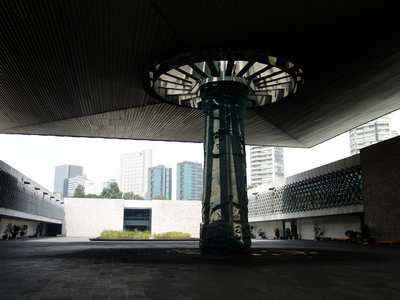Pedro Ramírez Vázquez: The Architecture of Contemporary Mexico City
Pedro Ramírez Vázquez was one of the most important architects of contemporary Mexico. His cultural and architectural conception was reflected in several important works, which are part of the historical-cultural heritage and urban landscape of Mexico City.

One of the most important architects of contemporary Mexico was Pedro Ramírez Vázquez; his cultural and architectural conception was reflected in several important works, which are part of the historical-cultural heritage and urban landscape of Mexico City.
Pedro Ramírez Vázquez was born on April 16, 1919, in Mexico City. He studied at the Universidad Nacional Autónoma de México, where he was a professor of design and urban planning in the School of Architecture. Within his professional career, in addition to architecture, he was committed to teaching, which led him to be the founder and rector of the Universidad Autónoma Metropolitana.
The work of architect Pedro Ramírez Vázquez, during the second half of the last century, transcends into the first decades of the 21st century. In his architectural work, he combined the design used by pre-Hispanic cultures in their buildings with the incipient modernization that our country experienced during the time of the economic boom, which took place in the context of the so-called Mexican miracle.
Ramírez Vázquez's architectural legacy can be seen in emblematic constructions that survive to this day in the daily life of the inhabitants of Mexico City. The city owes to his talent and ingenuity such buildings as the Azteca Stadium (1962), the National Museum of Anthropology (1963), the New Basilica of Guadalupe (1976), and the Legislative Palace of San Lazaro (1979).
The importance of Pedro Ramírez Vázquez's designs lies in the incorporation of pre-Hispanic architectural elements. In several pre-Columbian buildings there are quadrangular designs: central patios that are surrounded by four volumes or horizontal constructions; such is the case of the pre-Hispanic complexes Las Columnas de Mitla, the Palacio de Quetzapapálotl in Tehotihuacan and the Cuadrángulo de las Monjas in Uxmal.

The pre-Hispanic quadrangular design influenced the construction of the National Museum of Anthropology and the Legislative Palace of San Lazaro. The orientation of both buildings is east-west, as Mesoamerican builders used to align their buildings.
In the case of the Legislative Palace of San Lazaro, we find that the design corresponds to that of a ceremonial pyramid, which is accessed after climbing two sets of stairs that are located on the four sides of the complex; inside the central courtyard, the facades of the buildings are ornamented with a multitude of lattices, inspired by the design of the Quadrangle of the Nuns.
The architect Ramírez Vázquez endowed his buildings with these important pre-Hispanic elements, which led him to be considered, without a doubt, an obligatory reference for modern architecture in Mexico.
Ramírez Vázquez passed away in Mexico City on April 16, 2013, at the age of 94. His legacy continues to permeate the daily life of the Mexican capital.




